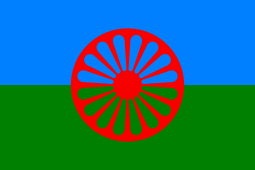Dom people
The Dom (also called Domi; Arabic: دومي / ALA-LC: Dūmī, دومري / Dūmrī, Ḍom / ضوم or دوم, or sometimes also called Doms) are a people with origins in the Indian subcontinent which through ancient migrations are found scattered across the Middle East, North Africa, Caucasus, Central Asia and still parts of the Indian subcontinent. The traditional language of the Dom is Domari, an endangered Indo-Aryan language, thereby making the Dom an Indo-Aryan ethnic group. They have been associated with another traditionally itinerant ethnic group of Indo-Aryans variously called the Rom/Roma/Romani people: the two groups have been said to have separated from each other or, at least, to share a similar history. Specifically, the ancestors of both the Dom and the Rom/Roma/Romani left the Northern Indian subcontinent sometime between the 6th and 11th century.
 Domari / Romani flag | |
| Total population | |
|---|---|
| 2.2 million (estimated) | |
| Regions with significant populations | |
| Middle East, North Africa | |
| Languages | |
| Domari, Persian, Arabic (also various dialects), Azeri, Kurdish, Turkish, Pushtu, Syriac, Hebrew, Armenian | |
| Religion | |
| Romani religion, Islam, Christianity | |
| Related ethnic groups | |
| Romani people, Lom people, Domba, other Indo-Aryans |
Culture
The Dom have an oral tradition and express their culture and history through music, poetry and dance. Initially, it was believed that they were a branch of the Romani people, but recent studies of the Domari language suggest that they departed from the Indian subcontinent[1] earlier than the Romani, probably around the 6th century.[2]
The name used worldwide by this demographic to identify themselves is the term "Rrom" (or "Rom"),[3] which in the Romani language means a man. The words Rom, Dom and Lom are used to describe Romani peoples who diverged in the 6th century. Several tribes moved as far as Western Europe and are called Rom, while the ones who remained in Persia and Turkey are called Dom.[4]
Among the various Domari subgroups, the Ghawazi are the most famous for their dancing and music. The Ghawazi dancers have been associated with the development of the Egyptian raqs sharqi style.
Distribution
The majority of the estimated population of 2.2 million live in Turkey, Egypt and Iran with significant numbers in Iraq. Smaller populations are found in Afghanistan, Libya, Tunisia, Algeria, Morocco, Sudan, Jordan, Syria and other countries of the Middle East and North Africa.
The actual population is unknown as some Dom are excluded from national censuses and others label themselves in national terms rather than as Dom. Nowadays, they speak the dominant languages of their larger societies, but Domari, their national language, continues to be spoken by more insular communities. Iranians called them gurbati or kouli, both meaning "foreigners".
There is a large concentration of Dom in Jordan. Researchers claim that "they accommodate Arab racism by hiding their ethnic identity," since they would not be accepted into Arabian society once their true identity is revealed.[5] There is also a similar small community with some colonial Romanichal ancestors in Malta. That community is called the Maltese Romanichal.
See also
- Domari language
- Lom people
- Lyuli
- Zott
- Nawar (Syria)
- Jat of Afghanistan
- Origin of the Romani people
References
- Professor Yaron Matras (December 2012). "Domari". [romani] project. School of Languages, Linguistics and Cultures The University of Manchester. Retrieved 26 December 2012.
- Ian Hancock (2007–2008). "ON ROMANI ORIGINS AND IDENTITY". RADOC. RADOC The Romani Archives and Documentation Center The University of Texas at Austin. Archived from the original on 17 July 2011. Retrieved 26 December 2012.
- Roma people in Croatia. lovari.hr
- Donald Kenrick (2004). Gypsies: From the Ganges to the Thames. Univ of Hertfordshire Press. pp. 24–. ISBN 978-1-902806-23-5. Retrieved 26 December 2012.
- Marsh, Adrian & Strand, Elin (red.) (2006). Gypsies and the problem of identities: contextual, constructed and contested. Istanbul: Swedish Research Institute in Istanbul (Svenska forskningsinstitutet i Istanbul), p. 207
Tarlan, K. V (2018). Encouraging Integration and Social Cohesion of Syrian Dom Immigrants Proposal for a Regional Social Inclusion Strategy Turkey, Lebanon and Jordan. Gaziantep: Kırkayak Kültür
Tarlan, K. V., Faggo, H (2018). The "Other" Asylum Seekers from Syria: Discrimination, Isolation, and Social Exclusion Syrian Dom Asylum Seekers in the Crossfire. Gaziantep: Kırkayak Kültür - Kemal Vural Tarlan, Hacer Foggo The Dom The Other Asylum Seekers from Syria Report.pdf
External links
- Dom Research Center
- "The Gypsies of Jerusalem: the Forgotten People" By Amoun Sleem
- Domari The society of Gypsies in Jerusalem
- "The Gypsy People of Israel, Gaza & the West Bank" by Valery Novoselsky
- "Evolving, educating: Israel's Gypsy community" by Roi Mandel
- "The Dom People and their Children in Lebanon" by Terre des Hommes
- Encouraging Integration and Social Cohesion of Syrian Dom Immigrants Proposal for a Regional Social Inclusion Strategy Turkey, Lebanon and Jordan. By Kırkayak Kültür – Kemal Vural Tarlan
- From The Occupation of Iraq to "The Arab Spring": Gypsies in the Middle East by Kemal Vural Tarlan
- Middle East Gypsies